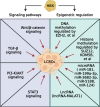Insight into the mechanisms regulating liver cancer stem cells by hepatitis B virus X protein
- PMID: 39529119
- PMCID: PMC11555838
- DOI: 10.1186/s13027-024-00618-y
Insight into the mechanisms regulating liver cancer stem cells by hepatitis B virus X protein
Abstract
Hepatocellular carcinoma (HCC) is a heterogeneous disease with high recurrence and mortality. It is well known that a large proportion of HCCs are caused by hepatitis B virus (HBV) infection. In particular, the HBV X protein (HBX), a multifunctional molecule produced by the virus, plays a leading role in hepatocarcinogenesis. However, the molecular mechanisms underlying HBX-mediated HCC remain not fully elucidated. Recently, liver cancer stem cells (LCSCs), a unique heterogeneous subpopulation of the malignancy, have received particular attention owing to their close association with tumorigenesis. Especially, the modulation of LCSCs by HBX by upregulating CD133, CD44, EpCAM, and CD90 plays a significant role in HBV-related HCC development. More importantly, not only multiple signaling pathways, including Wnt/β-catenin signaling, transforming growth factor-β (TGF-β) signaling, phosphatidylinositol-3-kinase (PI-3 K)/AKT signaling, and STAT3 signaling pathways, but also epigenetic regulation, such as DNA and histone methylation, and noncoding RNAs, including lncRNA and microRNA, are discovered to participate in regulating LCSCs mediated by HBX. Here, we summarized the mechanisms underlying different signaling pathways and epigenetic alterations that contribute to the modulation of HBX-induced LCSCs to facilitate hepatocarcinogenesis. Because LCSCs are important in hepatic carcinogenesis, understanding the regulatory factors controlled by HBX might open new avenues for HBV-associated liver cancer treatment.
Keywords: Epigenetic regulation; HBX; Hepatocellular carcinoma; Liver cancer stem cells; Signaling pathways.
© 2024. The Author(s).
Conflict of interest statement
Figures

Similar articles
-
Epigenetic silencing of SFRP1 and SFRP5 by hepatitis B virus X protein enhances hepatoma cell tumorigenicity through Wnt signaling pathway.Int J Cancer. 2014 Aug 1;135(3):635-46. doi: 10.1002/ijc.28697. Epub 2014 Jan 13. Int J Cancer. 2014. PMID: 24374650
-
Hepatitis B virus X protein accelerates the development of hepatoma.Cancer Biol Med. 2014 Sep;11(3):182-90. doi: 10.7497/j.issn.2095-3941.2014.03.004. Cancer Biol Med. 2014. PMID: 25364579 Free PMC article. Review.
-
Intracellular antibody targeting HBx suppresses invasion and metastasis in hepatitis B virus-related hepatocarcinogenesis via protein phosphatase 2A-B56γ-mediated dephosphorylation of protein kinase B.Cell Prolif. 2022 Nov;55(11):e13304. doi: 10.1111/cpr.13304. Epub 2022 Jul 10. Cell Prolif. 2022. PMID: 35811356 Free PMC article.
-
Hepatitis B virus X protein (HBx)-related long noncoding RNA (lncRNA) down-regulated expression by HBx (Dreh) inhibits hepatocellular carcinoma metastasis by targeting the intermediate filament protein vimentin.Hepatology. 2013 May;57(5):1882-92. doi: 10.1002/hep.26195. Hepatology. 2013. PMID: 23239537
-
Hepatitis B virus X protein and TGF-β: partners in the carcinogenic journey of hepatocellular carcinoma.Front Oncol. 2024 Jun 19;14:1407434. doi: 10.3389/fonc.2024.1407434. eCollection 2024. Front Oncol. 2024. PMID: 38962270 Free PMC article. Review.
References
Publication types
Grants and funding
- 21KJA310004/the Natural Science Foundation of the Jiangsu Higher Education Institutions
- BK20211347/the Natural Science Foundation of Jiangsu Province
- 82372245/National Natural Science Foundation of China
- PAPD/a project funded by the Priority Academic Program Development of Jiangsu Higher Education Institutions
LinkOut - more resources
Full Text Sources
Research Materials
Miscellaneous

